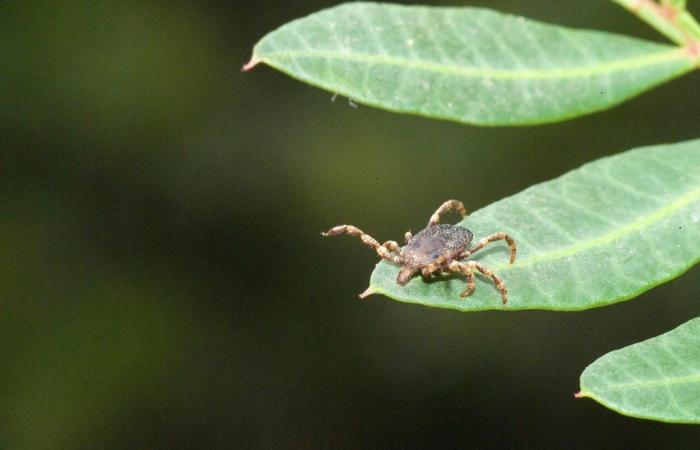By
Editorial News
Published on
June 23, 2024 at 12:16 p.m.
See my news
Follow News
In the great global ballet of viral diseases transmitted by insects or arachnids that feed on blood, certain viruses have played leading roles in recent years. Dengue, chikungunya, or Zika viruses have become famous in particular since they reached regions where they did not usually circulate, such as the south of France.
The Crimean-Congo hemorrhagic fever virus could soon be added to this list. Indeed, the number of infections with this virus transmitted by ticks has increased in Europe. In the fall of 2023, Public Health France reported its identification in a species of invasive ticks established in the south of the country. What do you need to know?
First direct identification in France
On October 24, 2023, Public Health France announced that the Crimean-Congo fever virus (CCFV) had been identified in ticks of the genus Hyalomma (also called striped-legged ticks) collected from cattle farms in the south of France.
In France, the only human case known so far was an imported case: that of a person coming from Senegal. With this exception, the virus had only been indirectly detected, notably in livestock, during seroprevalence surveys. These consist of searching the blood for the presence of antibodies directed against certain pathogens (which indicates infection by said pathogens).
This discovery, made by CIRAD specialists and confirmed by the National Reference Center for Viral Hemorrhagic Fevers at the Pasteur Institute, is important because it will make it possible to better assess the risks of emergence of this disease in our country. However, this is not a surprise.
A virus circulating in Europe
Since 2013, 13 cases of autochthonous CCHF – in other words, contracted in the country – have occurred in Spain. Furthermore, retrospective work also revealed that bags of blood collected in 2013 contained antibodies targeting the virus responsible for the disease, which means that the donors had been in contact with it. Since then, in Western Europe, the disease is considered to be permanently established.
It was in 1944, during the advance of the Red Army, that this pathogen was identified for the first time, in Crimea (Ukrainian region annexed in 2014 by Russia). In 1969, during an epidemic in Congo, scientists realized that the virus in question was the same as that of 1944. The association of the two names gave the term Crimean-Congo hemorrhagic fever.
We know today that this disease circulates from Asia (especially Asia Minor) to Africa, via Southern and Eastern Europe, particularly in the Balkans. How is this very large distribution area explained? The answer lies with the vector of this virus: the tick of the genus Hyalomma sp.
A tick that travels through the air
Ticks belonging to the genus Hyalomma sp (whose main species are H. marginaatum And H. lusitanicum) have been present around the Mediterranean for several decades.
Native to Asia and Africa, they are transported by migratory birds. Released above the territories flown over, they can establish themselves there when conditions are favorable. This is how Hyalomma arrived in Corsica in the 1950s.
It is now believed that climate change, which increases summer temperatures, decreases humidity, and increases minimum temperatures in winter, facilitates such settlements.
Another difference: ticks of the Hyalomma genus hunt actively, unlike other ticks which tend to stay on the lookout.
Conspiracy
After hatching, Hyalomma passes through three stages of development: larvae, nymphs and adults (males and females).
Like all ticks, Hyalomma alternates during its existence between “free” phases and parasitic phases during which it takes its blood meal from vertebrates, before each of its metamorphoses, or before laying eggs.
If the adults usually feed on large mammals (cattle, sheep, goats, horses, etc.), the hosts of the larvae and nymphs are generally small vertebrates (hedgehogs, shrews or rodents such as rats, mice, hares and rabbits, etc.). ).
When a tick contaminated with the Crimean-Congo hemorrhagic fever virus feeds on a host, the virus can pass into its blood, and then contaminate other ticks which will in turn spread the virus.
There is also horizontal transmission called “co-feeding”, which corresponds to an exchange of saliva between ticks on the same bite site (without the virus passing through the blood). When a female Hyalomma infected lays eggs, the larvae which hatch also have an infective power.
The human being is an “accidental” host of the tick: he finds himself parasitized when he enters the ecosystems where the usual hosts of the tick live. Hyalomma. The peak of contamination, which corresponds to the peak of tick activity, is between April and July.
Severe forms in 20% of cases
Humans are generally contaminated with CCHF virus either through the bite of an infected tick or through contact with blood or other body fluids from infected farmed mammals.
Contamination can also occur by human-to-human transmission, in the event of contact with blood or body fluids (transmission in a hospital environment, particularly among very symptomatic patients, is a major concern), and sometimes via inert surfaces and contaminated materials. by the virus.
Very rare cases of possible sexual and maternal-fetal transmission are also suspected. Furthermore, transmission by aerosolization of droplets has sometimes been reported.
Classically the incubation (the duration between infection and the start of symptoms) is 2 to 14 days, with an average duration of 5 days. Although this virus is called Crimean-Congo hemorrhagic fever, it must be emphasized that hemorrhagic forms are not systematic.
Around 80% of infected people will only have a paucisymptomatic infection, limited to a picture of flu-like symptoms, or even asymptomatic (without any symptoms). The remaining 20% of infected patients, however, present symptomatic forms that can be severe and require hospitalization.
A disease that progresses in three phases
Generally severe forms of the disease occur in 3 phases:
The nonspecific prehemorrhagic phase, flu-like (day 1 to day 7): patients have fever, muscle pain (myalgia), headache (headache), nausea with vomiting and diarrhea;
- The hemorrhagic phase (day 7 to day 10): patients present with an external hemorrhagic syndrome resulting in various symptoms such as nosebleeds (epistaxis), small red or purplish spots on the skin (petechiae), bruising, hemorrhagic lesions of the skin and mucous membranes (purpura), bleeding gums (gingival bleeding), subconjunctival hemorrhages (the conjunctiva is the transparent tissue which covers the eyeball and the inner surface of the eyelids), the presence of blood in urine (hematuria) or in vomit (hematemesis);
- The convalescence phase (day 10 to day 20): this generally results in great fatigue (asthenia), tachycardia, instability of blood pressure, hair loss (alopecia), attention problems and memory, as well as psychological disorders (somatoform disorders: patients pay excessive attention to certain physical symptoms, which causes them worry and suffering).
- According to data from the World Health Organization, the fatality rate for severe forms of this hemorrhagic fever is 5% to 40%.
However, these data come from very diverse times and regions where access to care, particularly intensive care and resuscitation, may have proven difficult. This fatality rate can be greatly reduced when quality intensive care is provided early by experienced teams.
Diagnosis and management
The diagnosis of the disease is based on analyzes by RT-PCR, a molecular biology technique based on the detection and amplification of the genetic material of the virus.
Diagnostic support must be systematically transmitted to the National Reference Center (after discussion and agreement thereof) and the samples handled in premises adapted to the dangerousness of the virus. It is a class 4 pathogen, which must therefore be handled in a BSL4 (or P4) type containment enclosure, high biological containment laboratories dedicated to the study of the most dangerous viruses.
There is currently no clearly validated medication for symptomatic cases of Crimean-Congo hemorrhagic fever.
The WHO recommends administering Ribavirin IV as early as possible, an antiviral formerly used in particular to fight the hepatitis C virus. However, the various research studies aimed at evaluating the contribution of this molecule in curative failed to establish a solid consensus regarding its effectiveness.
The best care consists of quickly isolating the patient in dedicated services, with a team trained in this type of pathology capable of providing care aimed at treating the symptoms (hydration, transfusion). This type of unit exists within the reference health establishments which cover the territory.
For the moment, no validated vaccine is available to fight against CCHF (a vaccine is used in Bulgaria, but it has not been validated by international health authorities, due to the lack of reliable data concerning it). Several dozen vaccine platform projects are under development around the world, including in France.
What to do to protect yourself?
In the absence of specific treatment with consensus (vaccine and treatment), prevention is essential. Certain very simple actions prove very effective in limiting the risk of infection:
- In areas where ticks may be prevalent, wear closed shoes and covering clothing, and remember to put your pants inside your socks.
- favor marked paths (which also helps preserve nature);
- use skin repellents.
When returning from a walk or procedure, systematically inspect your body, particularly at the level of the folds of the skin, without forgetting the scalp.
If a tick is present, remove it using a tick remover, without using alcohol or ether. The bite site must then be disinfected and the general condition monitored. If symptoms appear within the following month, you should consult your doctor quickly.
Remember that not every bite is necessarily infectious; it depends on various factors (species of tick, number, stage of development, quantity of reservoir animals, etc.).
If the detection of the virus on vector ticks in the south of France is certainly a source of concern, we must not fall into alarmism. Indeed, for the moment, the probability of autochthonous vector transmission remains low in mainland France.
Only certain categories of the population are really at risk of contacting this pathology: farmers, breeders, veterinarians, knackers, as well as hikers and other campers during the summer.
Follow all the news from your favorite cities and media by subscribing to Mon -.






